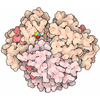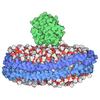+ データを開く
データを開く
- 基本情報
基本情報
| 登録情報 | データベース: PDB / ID: 6eny | ||||||||||||
|---|---|---|---|---|---|---|---|---|---|---|---|---|---|
| タイトル | Structure of the human PLC editing module | ||||||||||||
 要素 要素 |
| ||||||||||||
 キーワード キーワード | IMMUNE SYSTEM / adaptive immunity / antigen processing / chaperone / MHC class I | ||||||||||||
| 機能・相同性 |  機能・相同性情報 機能・相同性情報MHC class Ib protein complex assembly / peptide antigen stabilization / Tapasin-ERp57 complex / Calnexin/calreticulin cycle / response to biphenyl / MHC class I protein complex binding / TAP2 binding / TAP1 binding / cytolytic granule / positive regulation of dendritic cell chemotaxis ...MHC class Ib protein complex assembly / peptide antigen stabilization / Tapasin-ERp57 complex / Calnexin/calreticulin cycle / response to biphenyl / MHC class I protein complex binding / TAP2 binding / TAP1 binding / cytolytic granule / positive regulation of dendritic cell chemotaxis / protein disulfide-isomerase / ATF6 (ATF6-alpha) activates chaperone genes / Assembly of Viral Components at the Budding Site / cortical granule / negative regulation of trophoblast cell migration / nuclear receptor-mediated glucocorticoid signaling pathway / complement component C1q complex binding / response to peptide / cellular response to electrical stimulus / regulation of meiotic nuclear division / negative regulation of retinoic acid receptor signaling pathway / sequestering of calcium ion / endoplasmic reticulum quality control compartment / protein folding in endoplasmic reticulum / sarcoplasmic reticulum lumen / disulfide oxidoreductase activity / hormone binding / negative regulation of intracellular steroid hormone receptor signaling pathway / regulation of protein complex stability / nuclear export signal receptor activity / phospholipase C activity / cardiac muscle cell differentiation / retrograde vesicle-mediated transport, Golgi to endoplasmic reticulum / response to glycoside / cellular response to interleukin-7 / positive regulation of extrinsic apoptotic signaling pathway / cortical actin cytoskeleton organization / positive regulation of memory T cell activation / T cell mediated cytotoxicity directed against tumor cell target / TAP complex binding / Scavenging by Class A Receptors / Golgi medial cisterna / positive regulation of CD8-positive, alpha-beta T cell activation / CD8-positive, alpha-beta T cell activation / positive regulation of CD8-positive, alpha-beta T cell proliferation / nuclear androgen receptor binding / Scavenging by Class F Receptors / cellular response to lithium ion / CD8 receptor binding / protein disulfide isomerase activity / response to testosterone / antigen processing and presentation of exogenous peptide antigen via MHC class I / beta-2-microglobulin binding / MHC class I protein binding / endoplasmic reticulum exit site / antigen processing and presentation of endogenous peptide antigen via MHC class I via ER pathway, TAP-dependent / TAP binding / protection from natural killer cell mediated cytotoxicity / molecular sequestering activity / protein-disulfide reductase activity / antigen processing and presentation of endogenous peptide antigen via MHC class I via ER pathway, TAP-independent / antigen processing and presentation of endogenous peptide antigen via MHC class Ib / negative regulation of neuron differentiation / protein localization to nucleus / detection of bacterium / smooth endoplasmic reticulum / T cell receptor binding / phagocytic vesicle / extrinsic apoptotic signaling pathway / ERAD pathway / positive regulation of phagocytosis / positive regulation of cell cycle / endoplasmic reticulum-Golgi intermediate compartment membrane / endocytic vesicle lumen / positive regulation of substrate adhesion-dependent cell spreading / peptide binding / protein folding chaperone / positive regulation of endothelial cell migration / protein export from nucleus / acrosomal vesicle / : / : / response to endoplasmic reticulum stress / protein maturation / positive regulation of receptor binding / early endosome lumen / Nef mediated downregulation of MHC class I complex cell surface expression / negative regulation of receptor binding / DAP12 interactions / cellular response to iron ion / lumenal side of endoplasmic reticulum membrane / Endosomal/Vacuolar pathway / Antigen Presentation: Folding, assembly and peptide loading of class I MHC / peptide antigen assembly with MHC class II protein complex / antigen processing and presentation of exogenous protein antigen via MHC class Ib, TAP-dependent / cellular response to iron(III) ion / MHC class II protein complex / negative regulation of forebrain neuron differentiation / ER to Golgi transport vesicle membrane / peptide antigen assembly with MHC class I protein complex 類似検索 - 分子機能 | ||||||||||||
| 生物種 |  Homo sapiens (ヒト) Homo sapiens (ヒト) | ||||||||||||
| 手法 | 電子顕微鏡法 / 単粒子再構成法 / クライオ電子顕微鏡法 / 解像度: 5.8 Å | ||||||||||||
 データ登録者 データ登録者 | Trowitzsch, S. / Januliene, D. / Blees, A. / Moeller, A. / Tampe, R. | ||||||||||||
| 資金援助 |  ドイツ, 2件 ドイツ, 2件
| ||||||||||||
 引用 引用 |  ジャーナル: Nature / 年: 2017 ジャーナル: Nature / 年: 2017タイトル: Structure of the human MHC-I peptide-loading complex. 著者: Andreas Blees / Dovile Januliene / Tommy Hofmann / Nicole Koller / Carla Schmidt / Simon Trowitzsch / Arne Moeller / Robert Tampé /  要旨: The peptide-loading complex (PLC) is a transient, multisubunit membrane complex in the endoplasmic reticulum that is essential for establishing a hierarchical immune response. The PLC coordinates ...The peptide-loading complex (PLC) is a transient, multisubunit membrane complex in the endoplasmic reticulum that is essential for establishing a hierarchical immune response. The PLC coordinates peptide translocation into the endoplasmic reticulum with loading and editing of major histocompatibility complex class I (MHC-I) molecules. After final proofreading in the PLC, stable peptide-MHC-I complexes are released to the cell surface to evoke a T-cell response against infected or malignant cells. Sampling of different MHC-I allomorphs requires the precise coordination of seven different subunits in a single macromolecular assembly, including the transporter associated with antigen processing (TAP1 and TAP2, jointly referred to as TAP), the oxidoreductase ERp57, the MHC-I heterodimer, and the chaperones tapasin and calreticulin. The molecular organization of and mechanistic events that take place in the PLC are unknown owing to the heterogeneous composition and intrinsically dynamic nature of the complex. Here, we isolate human PLC from Burkitt's lymphoma cells using an engineered viral inhibitor as bait and determine the structure of native PLC by electron cryo-microscopy. Two endoplasmic reticulum-resident editing modules composed of tapasin, calreticulin, ERp57, and MHC-I are centred around TAP in a pseudo-symmetric orientation. A multivalent chaperone network within and across the editing modules establishes the proofreading function at two lateral binding platforms for MHC-I molecules. The lectin-like domain of calreticulin senses the MHC-I glycan, whereas the P domain reaches over the MHC-I peptide-binding pocket towards ERp57. This arrangement allows tapasin to facilitate peptide editing by clamping MHC-I. The translocation pathway of TAP opens out into a large endoplasmic reticulum lumenal cavity, confined by the membrane entry points of tapasin and MHC-I. Two lateral windows channel the antigenic peptides to MHC-I. Structures of PLC captured at distinct assembly states provide mechanistic insight into the recruitment and release of MHC-I. Our work defines the molecular symbiosis of an ABC transporter and an endoplasmic reticulum chaperone network in MHC-I assembly and provides insight into the onset of the adaptive immune response. | ||||||||||||
| 履歴 |
|
- 構造の表示
構造の表示
| ムービー |
 ムービービューア ムービービューア |
|---|---|
| 構造ビューア | 分子:  Molmil Molmil Jmol/JSmol Jmol/JSmol |
- ダウンロードとリンク
ダウンロードとリンク
- ダウンロード
ダウンロード
| PDBx/mmCIF形式 |  6eny.cif.gz 6eny.cif.gz | 257.1 KB | 表示 |  PDBx/mmCIF形式 PDBx/mmCIF形式 |
|---|---|---|---|---|
| PDB形式 |  pdb6eny.ent.gz pdb6eny.ent.gz | 168 KB | 表示 |  PDB形式 PDB形式 |
| PDBx/mmJSON形式 |  6eny.json.gz 6eny.json.gz | ツリー表示 |  PDBx/mmJSON形式 PDBx/mmJSON形式 | |
| その他 |  その他のダウンロード その他のダウンロード |
-検証レポート
| 文書・要旨 |  6eny_validation.pdf.gz 6eny_validation.pdf.gz | 952.6 KB | 表示 |  wwPDB検証レポート wwPDB検証レポート |
|---|---|---|---|---|
| 文書・詳細版 |  6eny_full_validation.pdf.gz 6eny_full_validation.pdf.gz | 967.9 KB | 表示 | |
| XML形式データ |  6eny_validation.xml.gz 6eny_validation.xml.gz | 40.3 KB | 表示 | |
| CIF形式データ |  6eny_validation.cif.gz 6eny_validation.cif.gz | 63.5 KB | 表示 | |
| アーカイブディレクトリ |  https://data.pdbj.org/pub/pdb/validation_reports/en/6eny https://data.pdbj.org/pub/pdb/validation_reports/en/6eny ftp://data.pdbj.org/pub/pdb/validation_reports/en/6eny ftp://data.pdbj.org/pub/pdb/validation_reports/en/6eny | HTTPS FTP |
-関連構造データ
- リンク
リンク
- 集合体
集合体
| 登録構造単位 | 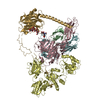
|
|---|---|
| 1 |
|
- 要素
要素
-タンパク質 , 5種, 5分子 BCDFG
| #1: タンパク質 | 分子量: 11748.160 Da / 分子数: 1 / 由来タイプ: 天然 / 由来: (天然)  Homo sapiens (ヒト) / 参照: UniProt: P61769 Homo sapiens (ヒト) / 参照: UniProt: P61769 |
|---|---|
| #2: タンパク質 | 分子量: 45761.184 Da / 分子数: 1 / 由来タイプ: 天然 / 由来: (天然)  Homo sapiens (ヒト) / 参照: UniProt: O15533 Homo sapiens (ヒト) / 参照: UniProt: O15533 |
| #3: タンパク質 | 分子量: 54341.102 Da / 分子数: 1 / 由来タイプ: 天然 / 由来: (天然)  Homo sapiens (ヒト) / 参照: UniProt: P30101, protein disulfide-isomerase Homo sapiens (ヒト) / 参照: UniProt: P30101, protein disulfide-isomerase |
| #4: タンパク質 | 分子量: 38363.535 Da / 分子数: 1 / 由来タイプ: 天然 / 由来: (天然)  Homo sapiens (ヒト) / 参照: UniProt: P04439 Homo sapiens (ヒト) / 参照: UniProt: P04439 |
| #5: タンパク質 | 分子量: 46507.145 Da / 分子数: 1 / 由来タイプ: 天然 / 由来: (天然)  Homo sapiens (ヒト) / 参照: UniProt: P27797 Homo sapiens (ヒト) / 参照: UniProt: P27797 |
-糖 , 2種, 2分子
| #6: 多糖 | 2-acetamido-2-deoxy-beta-D-glucopyranose-(1-4)-2-acetamido-2-deoxy-beta-D-glucopyranose |
|---|---|
| #7: 多糖 | beta-D-glucopyranose-(1-3)-alpha-D-mannopyranose-(1-2)-alpha-D-mannopyranose-(1-2)-alpha-D-mannopyranose タイプ: oligosaccharide / 分子量: 666.578 Da / 分子数: 1 / 由来タイプ: 組換発現 |
-実験情報
-実験
| 実験 | 手法: 電子顕微鏡法 |
|---|---|
| EM実験 | 試料の集合状態: PARTICLE / 3次元再構成法: 単粒子再構成法 |
- 試料調製
試料調製
| 構成要素 | 名称: Protein Complex / タイプ: COMPLEX / Entity ID: #1-#5 / 由来: NATURAL |
|---|---|
| 分子量 | 実験値: NO |
| 由来(天然) | 生物種:  Homo sapiens (ヒト) Homo sapiens (ヒト) |
| 緩衝液 | pH: 7.5 |
| 試料 | 濃度: 2 mg/ml / 包埋: NO / シャドウイング: NO / 染色: NO / 凍結: YES |
| 試料支持 | グリッドのタイプ: C-flat-2/2 |
| 急速凍結 | 装置: FEI VITROBOT MARK IV / 凍結剤: ETHANE / 湿度: 100 % / 凍結前の試料温度: 277 K |
- 電子顕微鏡撮影
電子顕微鏡撮影
| 実験機器 |  モデル: Titan Krios / 画像提供: FEI Company |
|---|---|
| 顕微鏡 | モデル: FEI TITAN KRIOS |
| 電子銃 | 電子線源:  FIELD EMISSION GUN / 加速電圧: 300 kV / 照射モード: FLOOD BEAM FIELD EMISSION GUN / 加速電圧: 300 kV / 照射モード: FLOOD BEAM |
| 電子レンズ | モード: BRIGHT FIELD |
| 撮影 | 電子線照射量: 55 e/Å2 / 検出モード: COUNTING フィルム・検出器のモデル: GATAN K2 QUANTUM (4k x 4k) |
- 解析
解析
| EMソフトウェア |
| ||||||||||||||||||||||||||||||||||||
|---|---|---|---|---|---|---|---|---|---|---|---|---|---|---|---|---|---|---|---|---|---|---|---|---|---|---|---|---|---|---|---|---|---|---|---|---|---|
| CTF補正 | 詳細: CTF correction was performed internally in Relion and Frealign タイプ: NONE | ||||||||||||||||||||||||||||||||||||
| 対称性 | 点対称性: C1 (非対称) | ||||||||||||||||||||||||||||||||||||
| 3次元再構成 | 解像度: 5.8 Å / 解像度の算出法: FSC 0.143 CUT-OFF / 粒子像の数: 141078 / 対称性のタイプ: POINT | ||||||||||||||||||||||||||||||||||||
| 精密化 | 最高解像度: 5.8 Å |
 ムービー
ムービー コントローラー
コントローラー







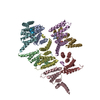

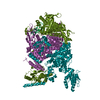
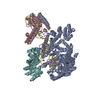
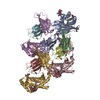
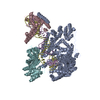
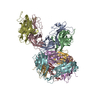

 PDBj
PDBj





